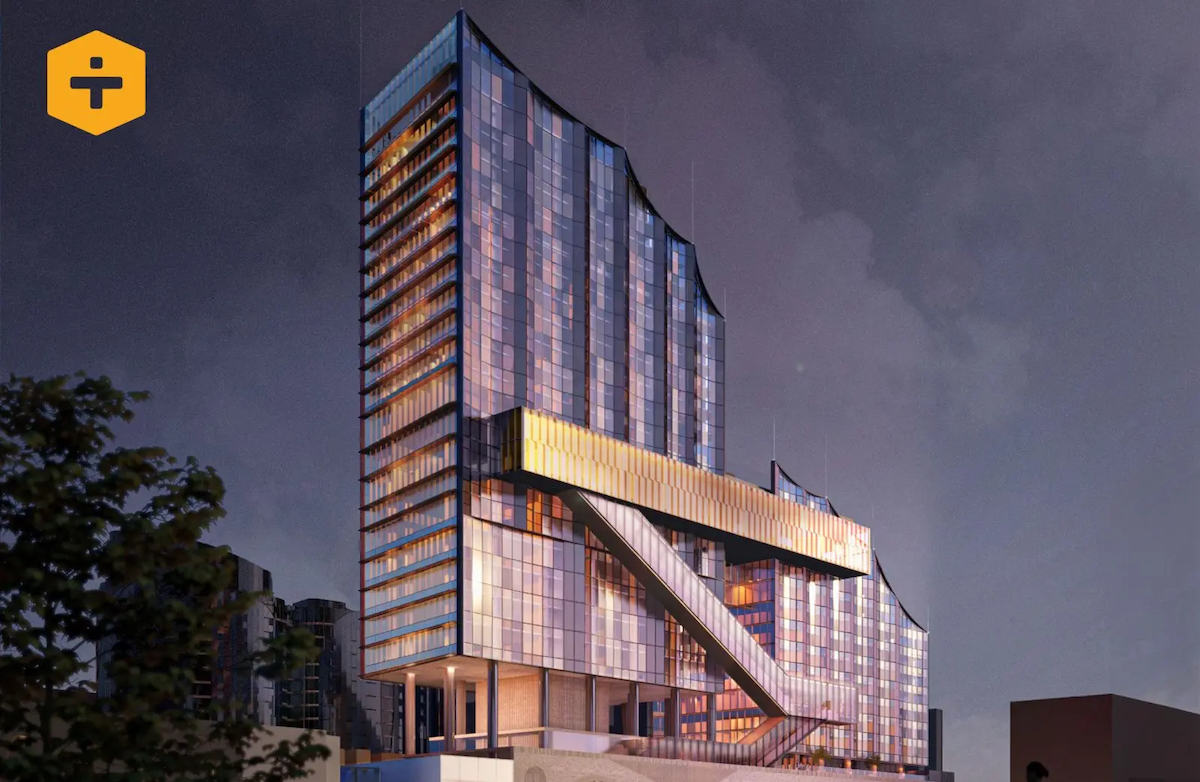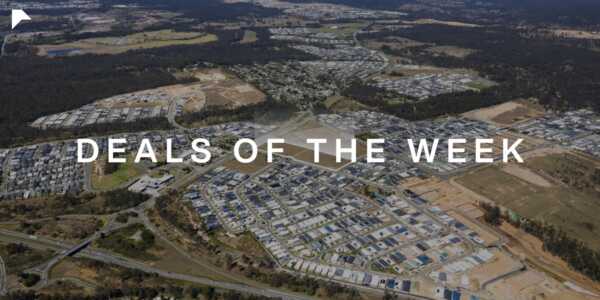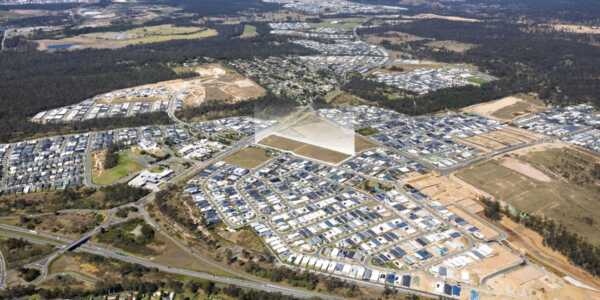Above: A render of the 28-38 Pearl River Road, Docklands project, which will include a 200-key Collection by TFE Hotel and premium 105-room A by Adina hotel.
Author: Blare Burnet, The Urban Developer
Reliant on international tourism, and to a lesser degree immigration, Australian hotels took a big hit during Covid and have only just started to bounce back in the past 12 months.
But we should expect a boom this year as international traveller numbers ramp up, with expectations from Tourism Research Australia that by 2028 Australia will have 1.9 million visitors from China alone—that’s one in six international arrivals.
TFE Hotels and Capital Alliance are major players in the space, recently teaming for a $340-million Docklands hotel development, which was greenlit in mid-2023 with construction set to begin this year.
TFE Hotels director of development John Sutcliffe says that their hotels portfolio continued to exceed expectations.
“Much of this was buoyed by the ongoing return of international visitors, as well as increased events including concerts and the Women’s World Cup,” Sutcliffe says.
“And although domestic leisure demand is expected to soften to some extent after the excitement of post-Covid, we continue to experience increasing visitation from overseas. “And once Asian markets pick up, we hope to see occupancies continue to improve.”
Experts at CBRE are expecting further growth after occupancy levels grew across all major markets in 2023.
“Sydney, Brisbane and Melbourne all increased by more 12 per cent compared to the previous corresponding period,” says CBRE director, Capital Markets – Hotels, Vasso Zographou.
“Annual daily rates (ADR) materially outperformed 2019 rates across all major markets. Brisbane has been the largest beneficiary of ADR growth, up 31 per cent when compared to 2019 levels.
“Subsequently, [revenue per available room] levels across Australia have grown significantly and have continued to outpace inflation, providing a positive outlook for the sector in 2024.”
CHANGING DEMOGRAPHICS
One of the factors potentially softening ADRs in the coming year will be a move away from “revenge tourism”—making trips that were cancelled or rescheduled during the global pandemic, although that should be offset by the return of Asian tourists.
“The softening of DRs represents the market segmentation switch from Leisure FIT (free independent traveller) and the so-called revenge tourism boom after the pandemic back to corporate business and international leisure,” Zographou says.
The main driver back to pre-pandemic traveller levels is the return of tourists from China, which overtook New Zealand as Australia’s most important tourism market after the Global Financial Crisis.
TFE Hotels also launched plans for a $150-million Southbank hotel alongside MaxCap and Time & Place. It is set to open in 2025.
“In 2019, China ranked first for inbound travel to Australia, however, in 2023 they are sixth,” Zographou says.
“Visa approval was granted to short-term groups in August, 2023 but Australia is now awaiting the return of the higher spending Chinese free independent travellers.”
With the average length of stay for a Chinese tourist averaging 40 days, coupled with high spending, this return could mean an impressive uptick for Australian tourism.
Clearly, there is major headroom for growth, especially with Chinese tourism returning, and on-the-ground hotel developers such as Capital Alliance, which has 500 rooms in operation in Melbourne, have noticed the same.
“Specifically speaking about Australia, we’ve not really seen the Asian-bound tourists return,” chief executive of Capital Alliance Mohan Du says.
“Keep in mind that the current influx of travellers to Australia aren’t necessarily the traditional tourists we are used to seeing.
“Most people travelling to Australia in 2023 were mostly here to visit family, friends and attend special events. In 2024 we expect to see more traditional tourists return.
TFE’s Adina Bondi Beach has also been integrated into The Hub Hall Street, offering boutique eateries.
“[International visitor numbers are] starting to ramp up and will continue to strengthen the sector.”
John Sutcliffe agrees and says that markets have been slow to return up until this point.
“Current trends support a positive outlook for 2024,” he says.
“The challenge will be the timing between a reduction in domestic travel levels and the return of Asian inbound travellers.”
CHALLENGES IN THE SECTOR
But there are challenges facing the sector this year, however. Two of the biggest are the stabilisation of hotel performance and construction costs, according to Capital Alliance’s Du.
“There will always be investor interest in the sector. But given what has happened during the past couple of years, institutional investors want to see a stabilisation of hotel performance first,” he says.
“Construction costs will most definitely impact new builds and refurbishment of older properties. Many developers, us included, are considering waiting it out to better understand the rates environment and if a cut will actually happen this year.”
Sites in the Sydney CBD have always been scarce, so developers are always exploring opportunities in that market, CBRE says.
As reported last week, Sydney hotels have been described as the best performing in the Australian market, and that isn’t likely to change, even though other locations are opening up.
“Melbourne and Sydney will continue to be destination of choice for the majority of visitors as gateway cities, which means the majority of opportunities for new development will remain with these two cities,” says Du.
“The outlook for Melbourne can only improve from last year.”
CBRE’s hotel experts say that despite a softening of average daily rate growth, investors remain interested in the Australian hotel market, considering it an “investment safe haven”.
“This is a result of Australia’s mature markets, stable political system, legal and financial transparency and its multicultural society offering appeal to visit from all international countries,” Zographou says.
In terms of hotel sales, Australian has had a strong rebound. In 2023 there was around $2.55 billion in accommodation hotel sales. CBRE handled about 70 per cent of those transactions
TFE Hotels’ John Sutcliffe says interest from local and overseas investors remains strong, and there is potential for refurbishment and new builds in various markets.
“New, well-located hotels will always perform well, with ageing non-refurbished products typically more exposed in periods where there is a supply and demand imbalance.
Integrating hotels into mixed-use developments, such as the Interlude at Pentridge, has proved successful for developers and operators.
“The TFE team will continue to work with our owners on refurbishment programs to ensure a quality portfolio of assets and strong market performance.
“An increase in demand, particularly for specific events and over high demand periods, will also boost occupancy levels into city fringe hotels, an area becoming more popular with investors.”
As well, TFE is seeing increasing opportunities to partner with developers as part of larger mixed-use sites, or for the conversion of current buildings into hotels from their current use, says Sutcliffe.
TFE’s The Interlude, part of the $1-billion Pentridge lifestyle precinct, has proven this model to the group, he says.
THE FUTURE OF HOTELS
Thankfully, while international visitors are set to boom, adequate supply does exist in the hotels sector, according to CBRE.
Between 2020 and 2024, supply will have increased by 24,050 rooms Australia wide, the hotel agents say, with 2.8 per cent growth expected this year.
CBRE is forecasting ADR growth in 2024—up by 3.8 per cent in Brisbane, 2.75 per cent in Sydney and 2.0 per cent in Melbourne.
“However, supply-chain difficulties and general increases in construction costs [including labour] impacts the feasibility for newbuild hotels,” Zographou says.
“This requires developers and financiers to critically review all new projects from a feasibility perspective.”
Another challenge facing the sector this year is the capital expenditure required for refurbishment of older stock to ensure the asset stays competitive.
“Living sectors such as build-to-rent (BTR) and co-living have emerged as a popular asset classes duirng the past 12 to 24 months, and we expect this to continue in instances where repurposing the asset class will present a better alternative.”
However, other operators are not so certain given the extent of changes needed to renovate hotels into residential properties.
“There has been a lot of talk about converting old hotels to residential use—I doubt this will happen in 2024,” Du says.
Revenue per available room is also expected to grow throughout 2024: in Sydney by 7.1 per cent, Melbourne by 7.9 per cent, Brisbane by 3.9 per cent and Perth by 5.6 per cent.
But progress is being made with major developments including the TFE/Capital Alliance Docklands project, which received planning permission six months ago.
Elsewhere, TFE has The Eve Hotel Sydney and the Hannah St Hotel at Melbourne’s Southbank in the works.
“We continue to actively seek leases for our casual living Adina brands across Australia and are in advanced talks with developers with regards to including Adina Apartment Hotels as part of their larger masterplan developments, as well as conversion of commercial spaces to apartment product,” TFE’s Sutcliffe says.
Hotels will also have to adapt to the changing times to take advantage of traveller numbers exceeding expectations.
“Hotels and brands will continue to focus and evolve experience-based offerings, with certain consumer segments seeking out more authentic, bespoke, and engaging offerings,” Sutcliffe says.
“The success of new international brand entrants will lead to further announcements and new entrants and the continued growth and success of independent bespoke lifestyle brands will see this as one of the faster growing market classes.”









